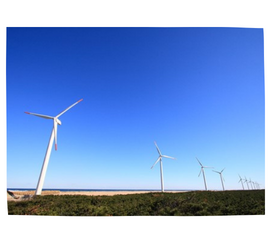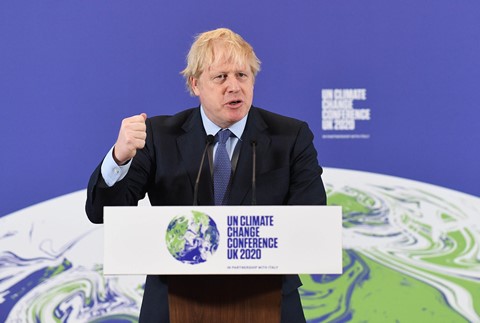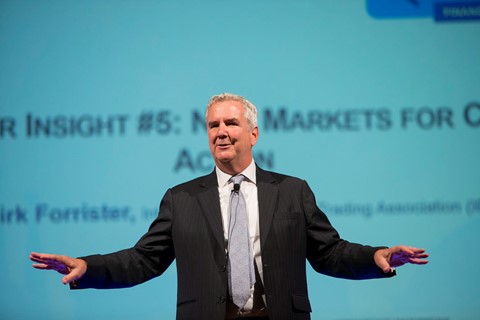At the United Nations climate negotiations in Glasgow, the international community agreed on one of the most effective policies for addressing climate change.
If you’re like me – young and a bit pessimistic about the future of our planet – you may be skeptical of any positive developments. After all, we constantly read news articles about the worsening impacts of climate change.
However, this news can’t be downplayed: the Glasgow Pact was historic. World leaders reached an unexpected compromise last November that promises a new market channel for governments, institutions and businesses to cut greenhouse gas emissions at a faster pace.

"Wind Power Farm." by skyseeker is licensed under CC BY 2.0.
Although far from perfect, this landmark agreement would create a global carbon trading market. The goal of Article 6 of the Paris Agreement was to create a voluntary global carbon market, but it was negotiators in Glasgow who ironed out the final details. By breathing new life into the 2015 accord, the Glasgow pact set up formal market rules for trading carbon emissions. This global carbon market will help reduce emissions and prevent the most catastrophic impacts of climate change.
How would this new carbon market work? To understand, let’s review some concepts from everyone’s favorite college course.
Recalling your Econ 101 classes, you probably remember that economists like using markets to deal with limited resources. Markets are decentralized and can enforce the allocation of scarce resources to address large-scale challenges.
Carbon markets set a price on greenhouse gas emissions and motivate governments and institutions to lower emissions and profit from selling carbon credits. To ensure its integrity, a carbon market requires regulations that guarantee the legitimacy of credits, prevent double counting, and sustain realistic credit prices.
The cap-and-trade systems that currently exist in the European Union, California, and China function on these basic economic concepts. Still, the rules of most carbon marketplaces vary because of regional differences, and much of the world still lacks any trading scheme. The Glasgow amendment to Article 6 will change that.
But resolving differences over the Article 6 language wasn't easy and almost scuttled the Glasgow negotiations, also known as the Conference of the Parties to the United Nations Framework Convention on Climate Change or COP 26 for short. Two issues--concerns about double counting credits and the status of so-called carryover credits--proved particularly contentious.
Double counting occurs when two countries trade a credit and both count it as part of their own carbon reductions (to learn more about this topic, check out last year’s Emory Climate Talks webinar with Professor Matthew Brander). Without preventive measures, this market malfunction can artificially inflate the calculation of how much carbon has been reduced.
The final compromise prevents carbon reductions from being counted twice. It was a concession to developing countries in Asia, Latin America, Africa and the Pacific islands, collectively known as the Global South. Rather than being forced to give in to more powerful market players, these countries now have the choice of counting a project for itself or trading it as a carbon credit.
As Renat Heuberger, chief executive of South Pole, a climate finance leader, explained, “You don’t want to deprive Senegal [for example] of its opportunity to decarbonize.” By empowering formerly colonized nations to make their own decisions on how to count a reduction, Heuberger said the double counting rule “avoids what could end up being a sense of carbon colonialism.”

"Boris Johnson launch of COP26" by UK Prime Minister is licensed under CC BY-NC-ND 2.0.
Let’s consider the other sticking point in the negotiations: the issue of carryover credits. These older credits are left over from a failed carbon market effort under the Kyoto Protocol of 1992. If included, these carryover credits--considered to be of poor quality and lacking integrity--could destabilize the new marketplace. They are governed by different rules and are sometimes known as ‘zombie credits’, a name that may sound deceptively entertaining, but would probably be left on the cutting room floor of a Walking Dead episode.
After debates that lasted until the final days of COP 26, negotiators defused the issue by including only credits registered after 2013 and limiting the length of time they could be traded.
Prominent non-profit and climate experts generally applauded the Article 6 compromise, underscoring the urgent need for climate action. They saw market-based incentives as a step forward that could lead to more ambitious climate initiatives.
Kelley Kizzier of the Environmental Defense Fund predicted the new rules will allow a new flow of private capital to developing countries. Chirag Gajjar of the World Resources Institute said Article 6 breaks the stalemate of the past and will create new opportunities for the private sector to engage in carbon reduction.
Dirk Forrister of the International Emissions Trading Association, a lobbying organization that supports market-based climate solutions, praised the agreement both for its ambition and its integrity. Forrister believes the market mechanism will push businesses and governments to curtail emissions.

"Dirk Forrister CEO International Emissions Trading Association" by World Bank Photo Collection is licensed under CC BY-NC-ND 2.0.
Still, legitimate criticisms of the Glasgow pact will need to be addressed in the future. The San José Principles Coalition, which includes 32 countries committed to strong carbon trading principles, said that the new agreement didn’t go far enough and lacks the "clarity, robustness and integrity" demanded by the Paris Agreement. There are also concerns that Article 6 could put Indigenous peoples and territories at increased risk unless sufficient safeguards are put in place.
COP 27 is scheduled to take place in Egypt this November and will spotlight climate funding and justice for developing countries. New discussions in Egypt should seek to address dissatisfaction in the Global South with the carbon trading agreement. COP 27 will provide an opportunity to remedy these flaws while maintaining the many benefits of a global carbon trading market.
Works Cited
Brooks, C., & Adler, K. (2021, November 15). COP26: Article 6 Rulebook Updated, But Remains Work in Progress. IHS Markit. https://cleanenergynews.ihsmarkit.com/research-analysis/cop26-article-6-rulebook-update-but-remains-work-in-progress.html
Cap and trade basics. (2021, May 25). Center for Climate and Energy Solutions. https://www.c2es.org/content/cap-and-trade-basics
COP26 Key Takeaways: Article 6 Explainer. (2021). Carbon Market Institute. https://carbonmarketinstitute.org/app/uploads/2021/11/COP26-Glasgow-Article-6-Explainer.pdf
COP26 Outcomes: Market mechanisms and non-market approaches (Article 6). (n.d.). United Nations Climate Change; United Nations Framework Convention on Climate Change. https://unfccc.int/process-and-meetings/the-paris-agreement/the-glasgow-climate-pact/cop26-outcomes-market-mechanisms-and-non-market-approaches-article-6#eq-1
Dalton, S. M. and M. (2021, November 14). COP26 Opens Path to International Carbon Trading. Wall Street Journal. https://www.wsj.com/articles/cop26-opens-path-to-international-carbon-trading-11636922314
Di Leva, C. E., & Vaughan, S. (2021, December 13). The Paris Agreement’s New Article 6 Rules. International Institute for Sustainable Development. https://www.iisd.org/articles/paris-agreement-article-6-rules
Dufrasne, G., & Crook, J. (2021, December 10). FAW: Deciphering Article 6 of the Paris Agreement. Carbon Market Watch. https://carbonmarketwatch.org/2021/12/10/faq-deciphering-article-6-of-the-paris-agreement
Favasuli, S., & Sebastian, V. (2021, June 10). Voluntary carbon markets: How they work, how they’re priced and who’s involved. S & P Global. https://www.spglobal.com/platts/en/market-insights/blogs/energy-transition/061021-voluntary-carbon-markets-pricing-participants-trading-corsia-credits
Home. (n.d.). United Nations Climate Change; United Nations Framework Convention on Climate Change. https://unfccc.int/
How cap and trade works. (n.d.). Environmental Defense Fund. https://www.edf.org/climate/how-cap-and-trade-works
Kizzier, K. (2021, November 13). COP26 Ends With a Strong Result on Carbon Markets and an International Call to Action for the Most Urgent Climate Priorities. Environmental Defense Fund. https://www.edf.org/media/cop26-ends-strong-result-carbon-markets-and-international-call-action-most-urgent-climate
Kizzier, K., Levin, K., & Rambharos, M. (2019, February 12). What You Need to Know About Article 6 of the Paris Agreement. World Resources Institute. https://www.wri.org/insights/what-you-need-know-about-article-6-paris-agreement
Klein, J. (2021, November 29). What the Passage of Article 6 Means for Carbon Markets . GreenBiz. https://www.greenbiz.com/article/what-passage-article-6-means-carbon-markets
Krukowska, E. (2021, November 12). Carbon Markets Draft at COP26 Prompts Warning From Activists. Bloomberg. https://www.bloomberg.com/news/articles/2021-11-12/carbon-markets-draft-at-cop26-prompts-warning-from-activists
Michaelowa, A., Shishlov, I., & Brescia, D. (2019). Evolution of International Carbon Markets: Lessons for the Paris Agreement. WIREs Climate Change, 10(6). https://doi.org/10.1002/wcc.613
Statement on Article 6 of Paris Agreement: NDN Collective and Indigenous Climate Action. (2021, November 12). Indian Country Today. https://indiancountrytoday.com/the-press-pool/statement-on-article-6-of-paris-agreement-ndn-collective-and-indigenous-climate-action
The future of the voluntary carbon market under the Paris Agreement—Professor Matthew Brander. (2021, July 22). Emory Climate Talks. https://www.youtube.com/watch?v=bRFKJVYHu1k
The Paris Agreement. (n.d.). United Nations Climate Change; United Nations Framework Convention on Climate Change. https://unfccc.int/process-and-meetings/the-paris-agreement/the-paris-agreement
UN Climate Change Conference UK 2021. (n.d.). https://ukcop26.org/
United Nations. (n.d.). All about the NDCs. United Nations. https://www.un.org/en/climatechange/all-about-ndcs
Watson, F. (2021, November 14). COP26: Nations Strike Deal on International Carbon Markets at Glasgow Summit. https://www.spglobal